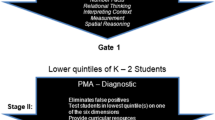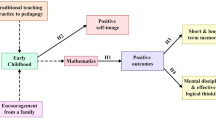Abstract
The present study examined the technical adequacy of curriculum-based measurement (CBM) measure of early numeracy for kindergarten through third grade students. Our CBM measures were developed to reflect broad and theoretically derived categories of mathematical thinking: quick retrieval, written computation, and number sense. The mastery of these three categories comprises the larger construct of numeracy proficiency for the early elementary grades. Approximately 300 students in each grade (Kindergarten to Grade 3) were administered a standardized measure, WJ-III, and the following timed measures: kindergarten—counting, missing number, number identification, quantity discrimination; Grade 1—counting, missing number, next number, number facts, number identification, quantity discrimination; Grades 2 and 3—computation, concepts, missing number, number facts, quantity discrimination. Alpha and test–retest reliabilities were assessed, and construct validity and criterion validity were examined for the CBM measures developed in the study. Overall, the results indicated that the measures were reliable and showed evidence to support both construct and concurrent validity. Methods to improve the measures are discussed.
Similar content being viewed by others
References
Allen, M. J., & Yen, W. M. (1979). Introduction to measurement theory. Monterey: Brooks/Cole.
Ansari, D., & Karmiloff-Smith, A. (2002). Atypical trajectories of number development: a neuroconstructivist perspective. Trends in Cognitive Sciences, 6(12), 511–516.
Baroody, A. J. (1992). The development of preschoolers’ counting skills and principles. In J. Bideaud, C. Meljac, & J. P. Fischer (Eds.), Pathways to number: Children’s developing numerical abilities (pp. 99–126). Hillsdale: Lawrence Erlbaum Associates Inc.
Bergan, J. R., Sladeczek, I. E., Schwarz, R. D., & Smith, A. N. (1991). Effects of a measurement and planning system on kindergarteners’ cognitive development and educational programming. American Educational Research Journal, 28(3), 683–714.
Black, P., & Wiliam, D. (1998). Inside the black box: Raising standards through classroom assessment. Phi Delta Kappan, 80(2), 139–148.
Bowman, B. T., Donovan, M. S., & Burns, M. S. (Eds.). (2001). Eager to learn: Educating our preschoolers. Washington, DC: National Academy Press.
Campbell, F. A., & Ramey, C. T. (1994). Effects of early intervention on intellectual and academic achievement: A follow-up study of children from low-income families. Child Development, 65(2), 684–698.
Chard, D. J., Clarke, B., Baker, S., Otterstedt, J., Braun, D., & Katz, R. (2005). Using measures of number sense to screen for difficulties in mathematics: Preliminary findings. Assessment for Effective Intervention, 30(2), 3–14.
Christ, T. J., & Vining, O. (2006). Curriculum-based measurement procedures to develop multiple-skill mathematics computation probes: Evaluation of random and stratified stimulus-set arrangements. School Psychology Review, 35, 387–400.
Clarke, B., & Shinn, M. R. (2004). A preliminary investigation into the identification and development of early mathematics curriculum-based measurement. School Psychology Review, 33, 234–248.
Crocker, L., & Algina, J. (1986). Introduction to classical modern test theory. Belmont: Wadsworth Group.
Cross, C. T., Woods, T. A., & Schweingruber, H. (Eds.). (2009). Mathematics learning in early childhood: Paths toward excellence and equity. Washington, DC: National Academy Press.
CTB, McGraw-Hill. (1976). Comprehensive tests of basic skills. Monterey: McGraw-Hill.
Deno, S. L. (1985). Curriculum-based measurement: The emerging alternative. Exceptional Children, 52, 219–232.
Deno, S. L., & Jiban, C. (2006). Elementary math measures. Baltimore: Presentation at the National Council for Exceptional Children conference.
Duncan, G.J., Dowsett, C.J., Claessens, A., Magnuson, K., Huston, A.C., Klebanov, P., Japel, C. (2007). School readiness and later achievement. Developmental Psychology, 43(6), 1428–1446.
Fuchs, L. S. (2004). The past, present, and future of curriculum-based measurement research. School Psychology Review, 33(2), 188–192.
Fuchs, L. S., & Fuchs, D. (1986). Effects of systematic formative evaluation: A meta-analysis. Exceptional Children, 53(3), 199–208.
Fuchs, L. S., Fuchs, D., Compton, D. L., Hamlett, C. L., & Seethaler, P. M. (2007). Mathematics screening and progress monitoring at first grade: Implications for responsiveness to intervention. Council for Exceptional Children, 73(3), 311–330.
Fuchs, L. S., Fuchs, D., & Hamlett, C. L. (1989a). Effects of instrumental use of curriculum-based measurement to enhance instructional programs. RASE: Remedial and Special Education, 10(2), 43–52.
Fuchs, L. S., Fuchs, D., & Hamlett, C. L. (1989b). Effects of alternative goal structures within curriculum-based measurement. Exceptional Children, 55(5), 429–438.
Fuchs, L. S., Fuchs, D., Hamlett, C. L., & Stecker, P. M. (1990a). The role of skills analysis in curriculum-based measurement in math. School Psychology Review, 19(1), 6–23.
Fuchs, L. S., Fuchs, D., Hamlett, C. L., Thompson, A., Roberts, P. H., Kubek, P., & Stecker, P. M. (1994). Technical features of a mathematics concepts and applications curriculum-based measurement system. Diagnostique, 19(4), 23–49.
Fuchs, L. S., Hamlett, C. L., & Fuchs, D. (1990b). Monitoring basic skills progress: Basic math computation and concepts and applications programs. Austin: Pro-Ed.
Gersten, R., Jordan, N. C., & Flojo, J. R. (2005). Early identification and interventions for students with mathematics difficulties. Journal of Learning Disabilities, 38(4), 293–304.
Ginsburg, H. P., Greenes, C., & Balfanz, R. (2003). Big math for little kids. Parsippany: Dale Seymour Publications.
Gulliksen, H. (1987). Theory of mental tests. Hillsdale: Erlbaum. (Reprinted from Theory of mental tests, by H. Gulliksen, 1950, New York: Wiley).
Hintze, J. M., Christ, T. J., & Keller, L. A. (2002). The generalizability of CBM survey-level mathematics assessments: Just how many samples do we need? School Psychology Review, 31, 540–553.
Howes, C., Burchinal, M., Pianta, R., Bryant, D., Early, D., Clifford, R., & Barbarin, O. (2008). Ready to learn? Children’s pre-academic achievement in pre-kindergarten programs. Early Childhood Research Quarterly, 23(1), 27–50.
Hu, L.-T., & Bentler, P. M. (1995). Evaluating model fit. In R. H. Hoyle (Ed.), Structural equation modeling: Concepts, issues, and applications (pp. 76–99). Thousand Oaks: Sage.
Hu, L.-T., & Bentler, P. M. (1999). Cutoff criteria for fit indexes in covariance structure analysis: Conventional criteria versus new alternatives. Structural Equation Modeling: A Multidisciplinary Journal, 6, 1–55.
Individuals with Disabilities Education Act, 20 U.S.C. § 1400 (2004).
Jordan, N. C., Kaplan, D., Locuniak, M. N., & Ramineni, C. (2007). Predicting first-grade math achievement from developmental number sense trajectories. Learning Disabilities Research & Practice, 22, 36–46.
Jordan, N. C., Kaplan, D., Nabors Oláh, L., & Locuniak, M. N. (2006). Number sense growth in Kindergarten: A longitudinal investigation of children at risk for mathematics difficulties. Child development, 77(1), 153–175.
Jordan, N. C., Kaplan, D., Ramineni, C., & Locuniak, M. N. (2009). Early math matters: kindergarten number competence and later mathematics outcomes. Developmental psychology, 45(3), 850–867.
Kaufman, A. S., & Kaufman, A. S. (1985). Kaufman test of educational achievement comprehensive form manual. Circle Pines: American Guidance Service.
Kim, S.-H. (1999). CIA: A Computer Program for Classical Item Analysis. [Computer Software]. Athens: University of Georgia.
Lembke, E. S., & Foegen, A. (2009). Identifying early numeracy indicators for kindergarten and first-grade students. Learning Disabilities Research & Practice, 24(1), 12–20.
Lembke, E. S., Foegen, A., Whittaker, T. A., & Hampton, D. (2008). Establishing technically adequate measures of progress in early numeracy. Assessment for Effective Intervention, 33(4), 206–214.
National Association for the Education of Young Children and National Council of Teachers of Mathematics. (2002). Position statement. Early childhood mathematics: Promoting good beginnings, Retrieved October 26, 2013 from the World Wide Web: http://www.naeyc.org/about/positions/psmath.asp.
National Council of Teachers of Mathematics. (1989). Curriculum and evaluation NCTM Standards for school mathematics. Reston: The National Council of Teachers of Mathematics Inc.
Pellegrino, J. W., Chudowsky, N., & Glaser, R. (Eds.). (2001). Knowing what students know: The science and design of educational assessment. Washington, DC: National Academy Press.
Russell, R. L., & Ginsburg, H. P. (1984). Cognitive analysis of children’s mathematics difficulties. Cognition and Instruction, 1, 217–244.
Siegler, R. S., Duncan, G. J., Davis-Kean, P. E., Duckworth, K., Claessens, A., Engel, M., et al. (2012). Early predictors of high school mathematic achievement. Psychological science, 23(7), 691–697.
Skiba, R., Magnusson, D., Marston, D., & Erickson, K. (1986). The assessment of mathematics performance in special education: Achievement tests, proficiency tests, or formative evaluation. Minneapolis: Special Services, Minneapolis Public Schools.
Speece, D. L., Molloy, D. E., & Case, L. P. (2003). Responsiveness to general education instruction as the first gate to learning disabilities identification. Learning Disabilities Research & Practice, 18, 145–156.
Stecker, P. M., Fuchs, L. S., & Fuchs, D. (2005). Using curriculum-based measurement to improve student achievement: Review of research. Psychology in the Schools, 42(8), 795–819.
The Psychological Corporation. (1992). Wechsler Individual Achievement Test. San Antonio: Author.
Tindal, G., Germann, G., & Deno, S. L. (1983). Descriptive research on the Pine County norms: A compilation of findings (Research Report No. 132). Minneapolis: University of Minnesota Institute for Research on Learning Disabilities.
Tucker, L. R., & Lewis, C. (1973). A reliability coefficient for maximum likelihood factor analysis. Psychometrika, 38, 1–10.
VanDerHeyden, A. M., Witt, J. C., Haquin, G., & Noell, G. (2001). The reliability and validity of curriculum-based measurement readiness probes for kindergarten students. School Psychology Review, 30, 363–382.
Vellutino, F. R., Scanlon, D. M., Sipay, E. R., Small, S. G., Pratt, A., Chen, R., & Denckla, M. B. (1996). Cognitive profiles of difficult-to-remediate and readily remediated poor readers: Early intervention as a vehicle for distinguishing between cognitive and experiential deficits as basic causes of specific reading disability. Journal of Educational Psychology, 88(4), 601–638.
Woodcock, R. W., McGrew, K. F., & Mather, N. (2001). Woodcock-Johnson III Tests of achievement. Itasca: Riverside Publishing.
Author information
Authors and Affiliations
Corresponding author
Electronic supplementary material
Below is the link to the electronic supplementary material.
Rights and permissions
About this article
Cite this article
Lee, YS., Lembke, E. Developing and evaluating a kindergarten to third grade CBM mathematics assessment. ZDM Mathematics Education 48, 1019–1030 (2016). https://doi.org/10.1007/s11858-016-0788-6
Accepted:
Published:
Issue Date:
DOI: https://doi.org/10.1007/s11858-016-0788-6




